Lexus HS250h 2011 Hybrid system / LEXUS 2011 HS250H OWNERS MANUAL (OM75037U)
Manufacturer: LEXUS, Model Year: 2011, Model line: HS250h, Model: Lexus HS250h 2011Pages: 628, PDF Size: 10.69 MB
Page 221 of 628
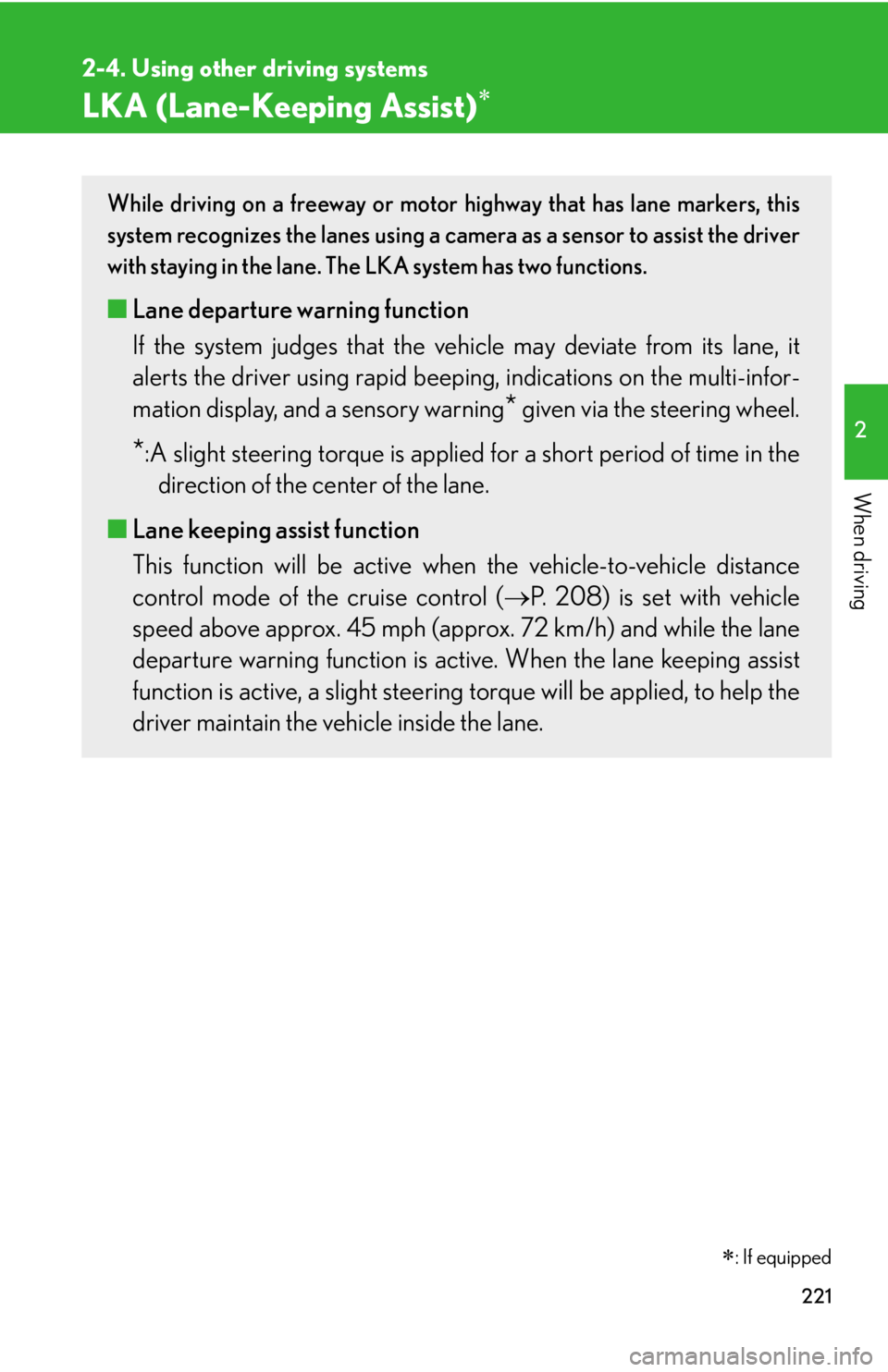
221
2-4. Using other driving systems
2
When driving
LKA (Lane-Keeping Assist)
: If equipped
While driving on a freeway or motor highway that has lane markers, this
system recognizes the lanes using a camera as a sensor to assist the driver
with staying in the lane. The LKA system has two functions.
■Lane departure warning function
If the system judges that the vehi cle may deviate from its lane, it
alerts the driver using rapid beepin g, indications on the multi-infor-
mation display, and a sensory warning
* given via the steering wheel.
*:A slight steering torque is applied fo r a short period of time in the
direction of the center of the lane.
■ Lane keeping assist function
This function will be active when the vehicle-to-vehicle distance
control mode of the cruise control ( P. 208) is set with vehicle
speed above approx. 45 mph (appr ox. 72 km/h) and while the lane
departure warning function is acti ve. When the lane keeping assist
function is active, a slight steering torque will be applied, to help the
driver maintain the vehicle inside the lane.
Page 222 of 628
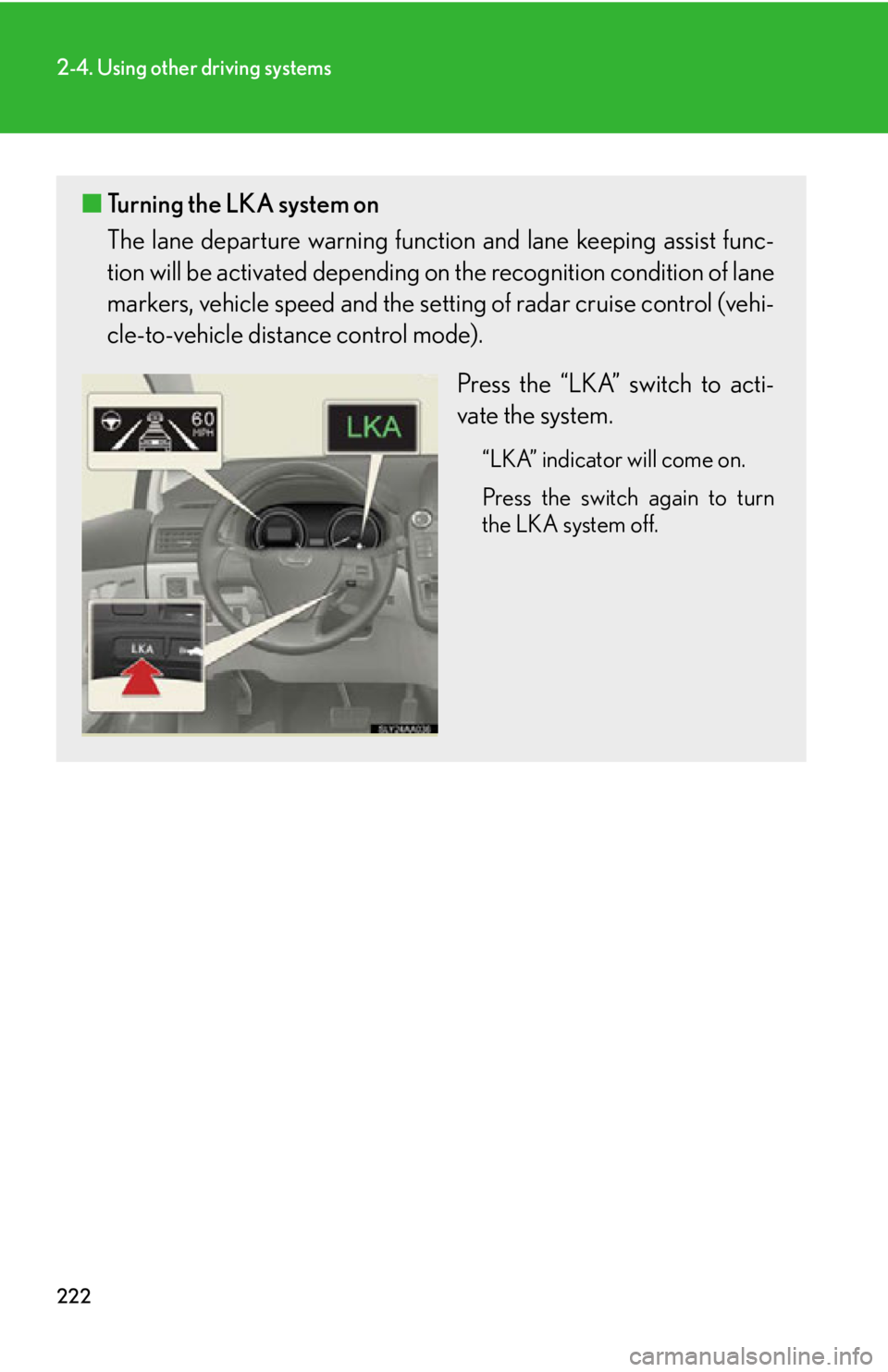
222
2-4. Using other driving systems
■Turning the LKA system on
The lane departure warning function and lane keeping assist func-
tion will be activated depending on the recog nition condition of lane
markers, vehicle speed and the setting of radar cruise control (vehi-
cle-to-vehicle dist ance control mode).
Press the “LKA” switch to acti-
vate the system.
“LKA” indicator will come on.
Press the switch again to turn
the LKA system off.
Page 223 of 628
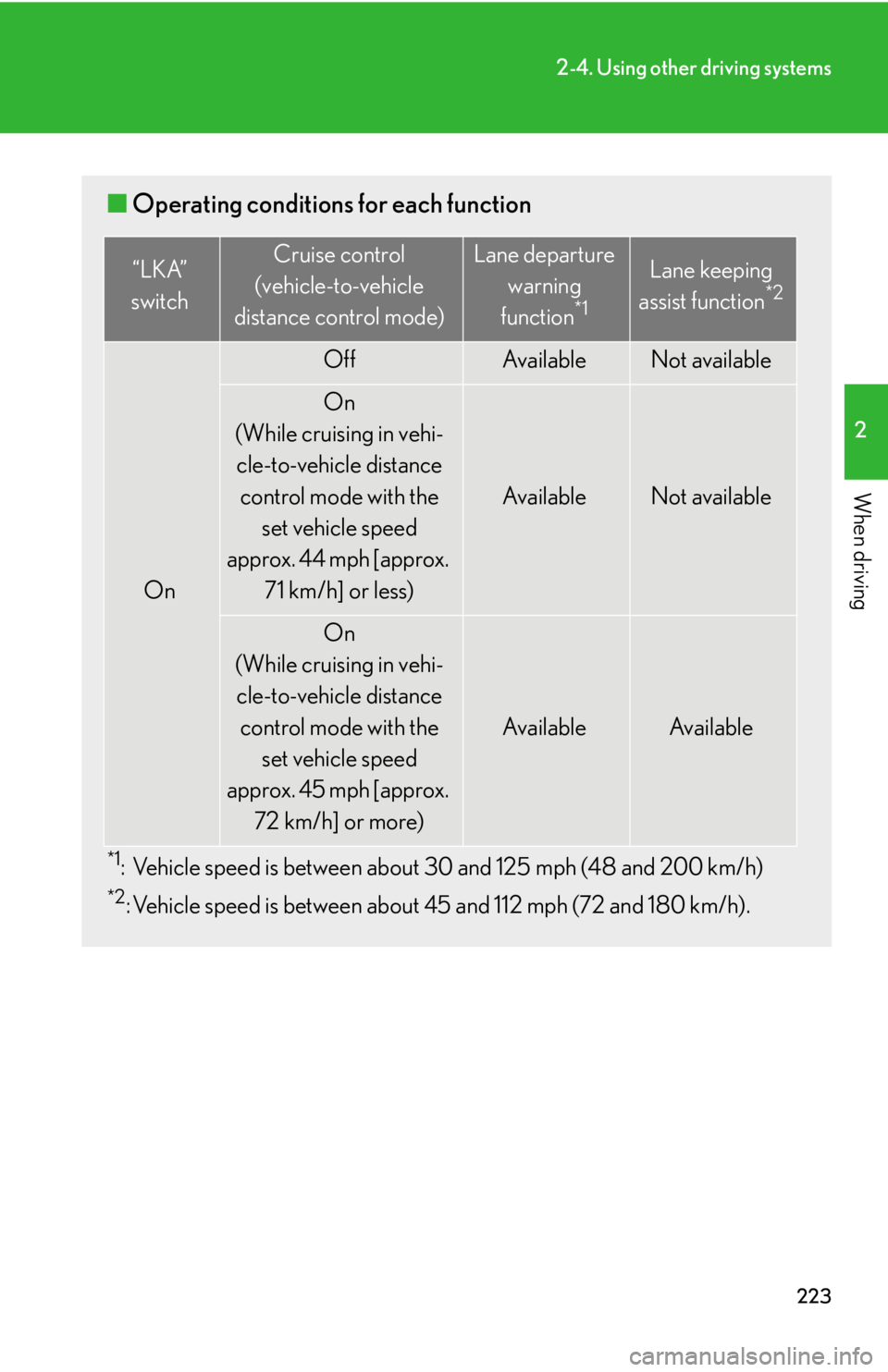
223
2-4. Using other driving systems
2
When driving
■Operating conditions for each function
*1: Vehicle speed is between about 30 and 125 mph (48 and 200 km/h)
*2: Vehicle speed is between about 45 and 112 mph (72 and 180 km/h).
“LKA”
switchCruise control
(vehicle-to-vehicle
distance control mode)Lane departure warning
function
*1
Lane keeping
assist function*2
On
OffAv a i l a b l eNot available
On
(While cruising in vehi- cle-to-vehicle distance
control mode with the set vehicle speed
approx. 44 mph [approx. 71 km/h] or less)
Av a i l a b l eNot available
On
(While cruising in vehi- cle-to-vehicle distance
control mode with the set vehicle speed
approx. 45 mph [approx.
72 km/h] or more)
Av a i l a b l eAvailable
Page 224 of 628
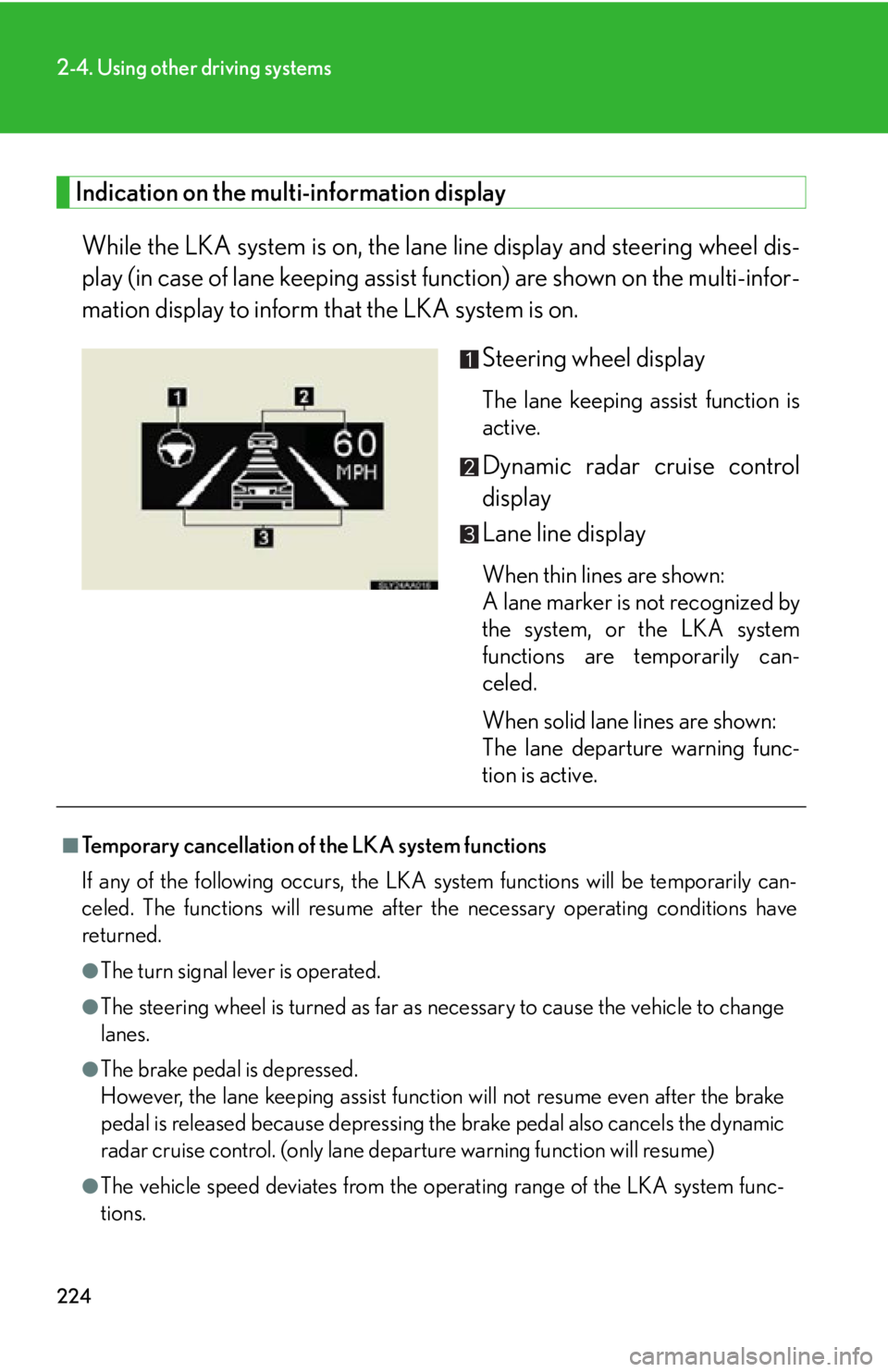
224
2-4. Using other driving systems
Indication on the multi-information displayWhile the LKA system is on, the lane line display and steering wheel dis-
play (in case of lane k eeping assist function) are shown on the multi-infor-
mation display to inform that the LKA system is on.
Steering wheel display
The lane keeping assist function is
active.
Dynamic radar cruise control
display
Lane line display
When thin lines are shown:
A lane marker is not recognized by
the system, or the LKA system
functions are temporarily can-
celed.
When solid lane lines are shown:
The lane departure warning func-
tion is active.
■Temporary cancellation of the LKA system functions
If any of the following occurs, the LKA system functions will be temporarily can-
celed. The functions will resume after the necessary operating conditions have
returned.
●The turn signal lever is operated.
●The steering wheel is turned as far as necessary to cause the vehicle to change
lanes.
●The brake pedal is depressed.
However, the lane keeping assist function will not resume even after the brake
pedal is released because depressing the brake pedal also cancels the dynamic
radar cruise control. (only lane departure warning function will resume)
●The vehicle speed deviates from the op erating range of the LKA system func-
tions.
Page 225 of 628

225
2-4. Using other driving systems
2
When driving
●When the lane lines cannot be recognized while driving.
●The wiper switch is set on “LO” or “HI” mode or is set on “AUTO” mode with
wipers operating at low or high speed.
●The no-handed driving warning activates while the lane keeping assist function
is active. (The buzzer will beep twice.)
●When the lane departure warning function is activated.
Once the lane departure warning function is activated, it will be temporarily
canceled and resume a few seconds later.
■No-handed driving warning
If the steering wheel is not operated for about 15 seconds on a straight road or
about 5 seconds on a curve, the buzzer will beep twice, indicators on the multi-
information display will flash, and the lane keeping assist function will be temporarily
canceled. If you drive the vehicle with your hands lightly touching the steering
wheel, this may also be detected as no-handed driving.
■When the vehicle has been parked in the sun
The LKA system functions may not be available for a while after driving has started.
In such cases, turn the LKA system off and turn it on again after normal temperature
returns. When the temperature in the cab in decreases and the temperature around
the camera sensor becomes suitable for it s operation, the functions will begin to
operate.
■Warning lights and messages for LKA
Warning lights and messages are used to in dicate a system malfunction or to inform
the driver of the need for caution while driving. ( P. 4 9 9 , 5 1 1 )
Page 226 of 628
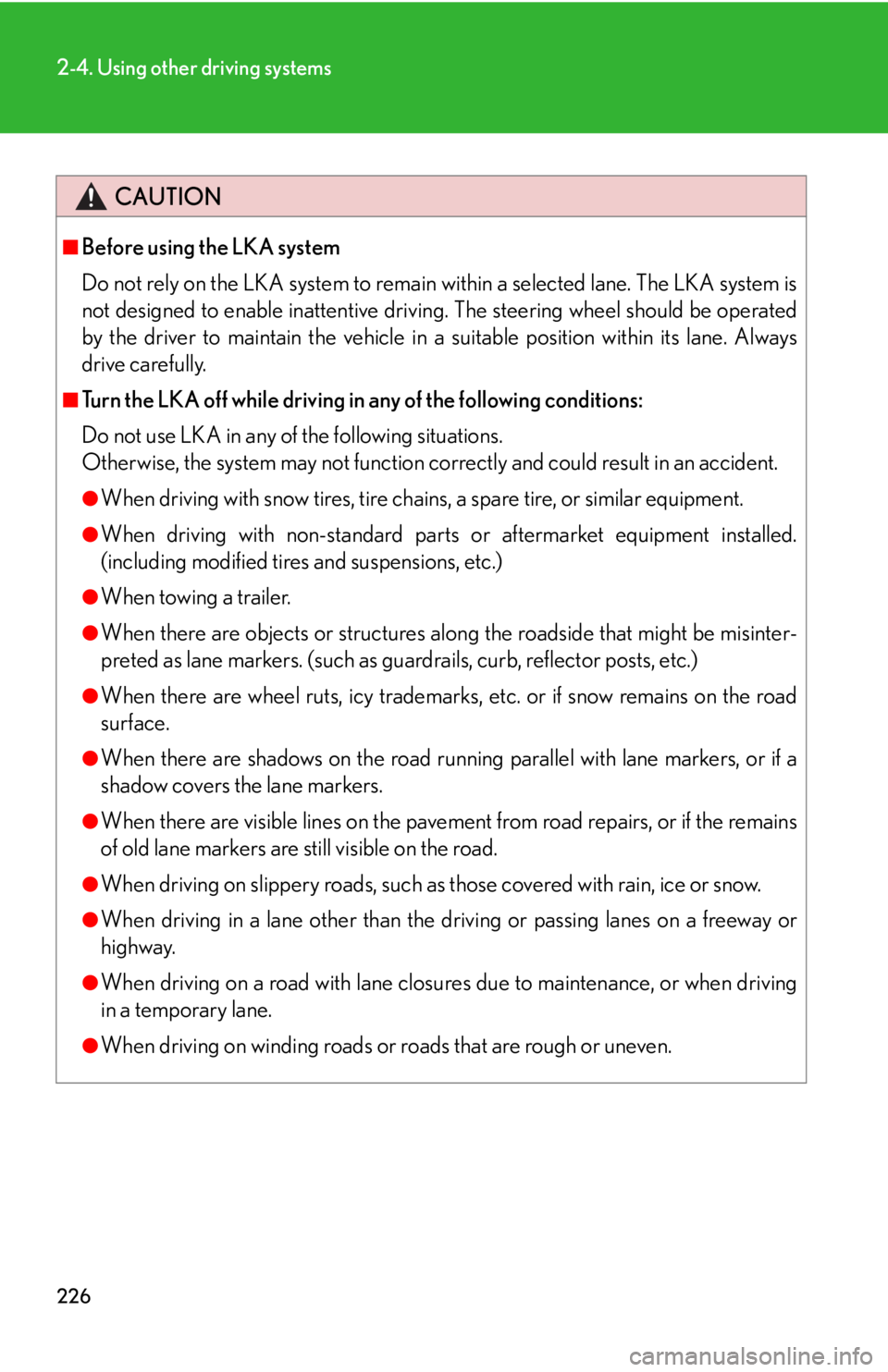
226
2-4. Using other driving systems
CAUTION
■Before using the LKA system
Do not rely on the LKA system to remain within a selected lane. The LKA system is
not designed to enable inattentive driving. The steering wheel should be operated
by the driver to maintain the vehicle in a suitable position within its lane. Always
drive carefully.
■Turn the LKA off while driving in any of the following conditions:
Do not use LKA in any of the following situations.
Otherwise, the system may not function correctly and could result in an accident.
●When driving with snow tires, tire ch ains, a spare tire, or similar equipment.
●When driving with non-standard parts or aftermarket equipment installed.
(including modified tires and suspensions, etc.)
●When towing a trailer.
●When there are objects or structures alon g the roadside that might be misinter-
preted as lane markers. (such as guardrails, curb, reflector posts, etc.)
●When there are wheel ruts, icy trademarks, etc. or if snow remains on the road
surface.
●When there are shadows on the road running parallel with lane markers, or if a
shadow covers the lane markers.
●When there are visible lines on the pavement from road repairs, or if the remains
of old lane markers are still visible on the road.
●When driving on slippery roads, such as those covered with rain, ice or snow.
●When driving in a lane other than the driving or passing lanes on a freeway or
highway.
●When driving on a road with lane closur es due to maintenance, or when driving
in a temporary lane.
●When driving on winding roads or roads that are rough or uneven.
Page 227 of 628
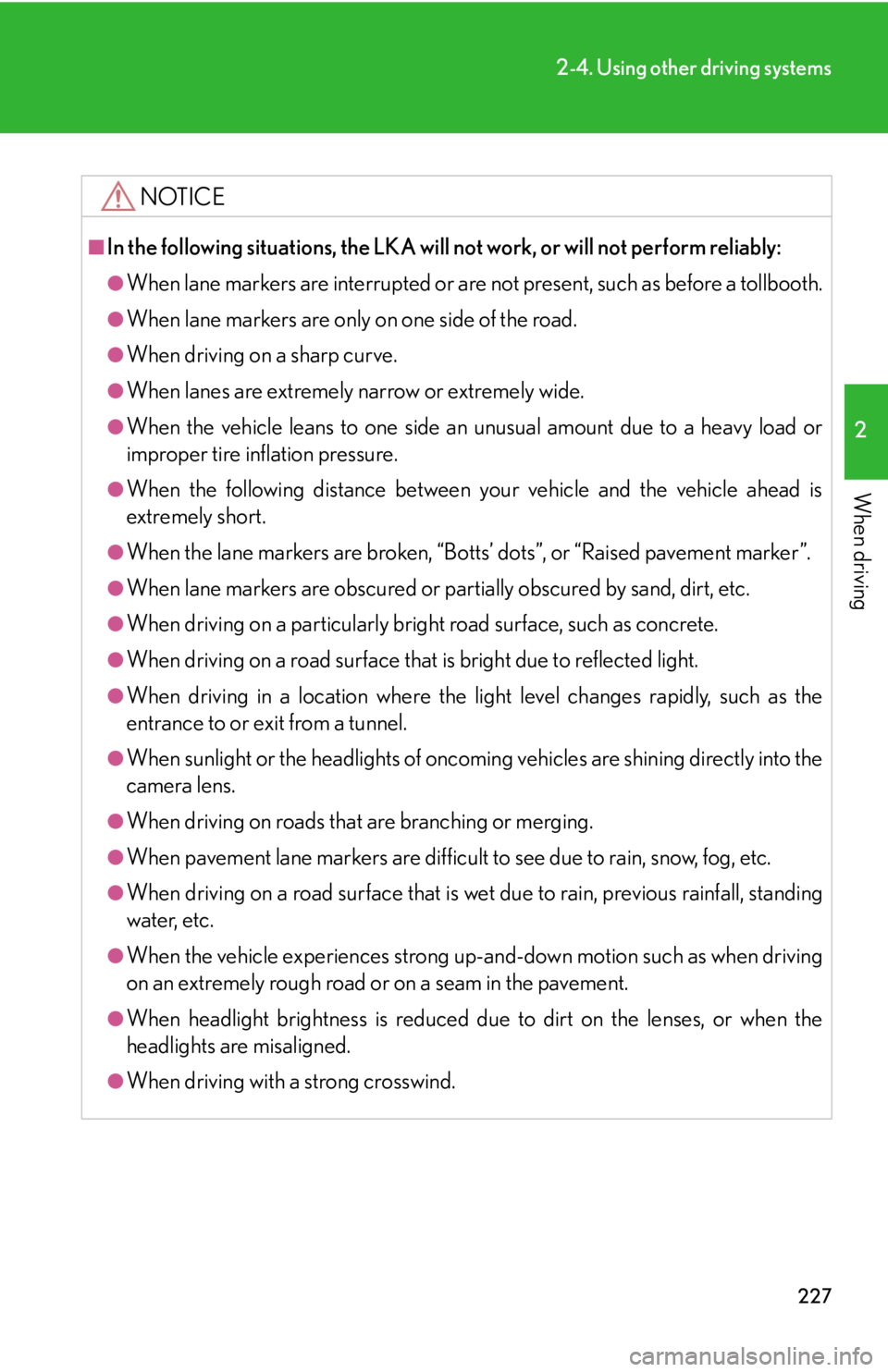
227
2-4. Using other driving systems
2
When driving
NOTICE
■In the following situations, the LKA will not work, or will not perform reliably:
●When lane markers are interrupted or are not present, such as before a tollbooth.
●When lane markers are only on one side of the road.
●When driving on a sharp curve.
●When lanes are extremely narrow or extremely wide.
●When the vehicle leans to one side an unusual amount due to a heavy load or
improper tire inflation pressure.
●When the following distance between your vehicle and the vehicle ahead is
extremely short.
●When the lane markers are broken, “Botts’ dots”, or “Raised pavement marker”.
●When lane markers are obscured or partially obscured by sand, dirt, etc.
●When driving on a particularly brig ht road surface, such as concrete.
●When driving on a road surface that is bright due to reflected light.
●When driving in a location where the light level changes rapidly, such as the
entrance to or exit from a tunnel.
●When sunlight or the headlights of oncoming vehicles are shining directly into the
camera lens.
●When driving on roads that are branching or merging.
●When pavement lane markers are difficult to see due to rain, snow, fog, etc.
●When driving on a road surface that is wet due to rain, previous rainfall, standing
water, etc.
●When the vehicle experiences strong up-a nd-down motion such as when driving
on an extremely rough road or on a seam in the pavement.
●When headlight brightness is reduced due to dirt on the lenses, or when the
headlights are misaligned.
●When driving with a strong crosswind.
Page 228 of 628
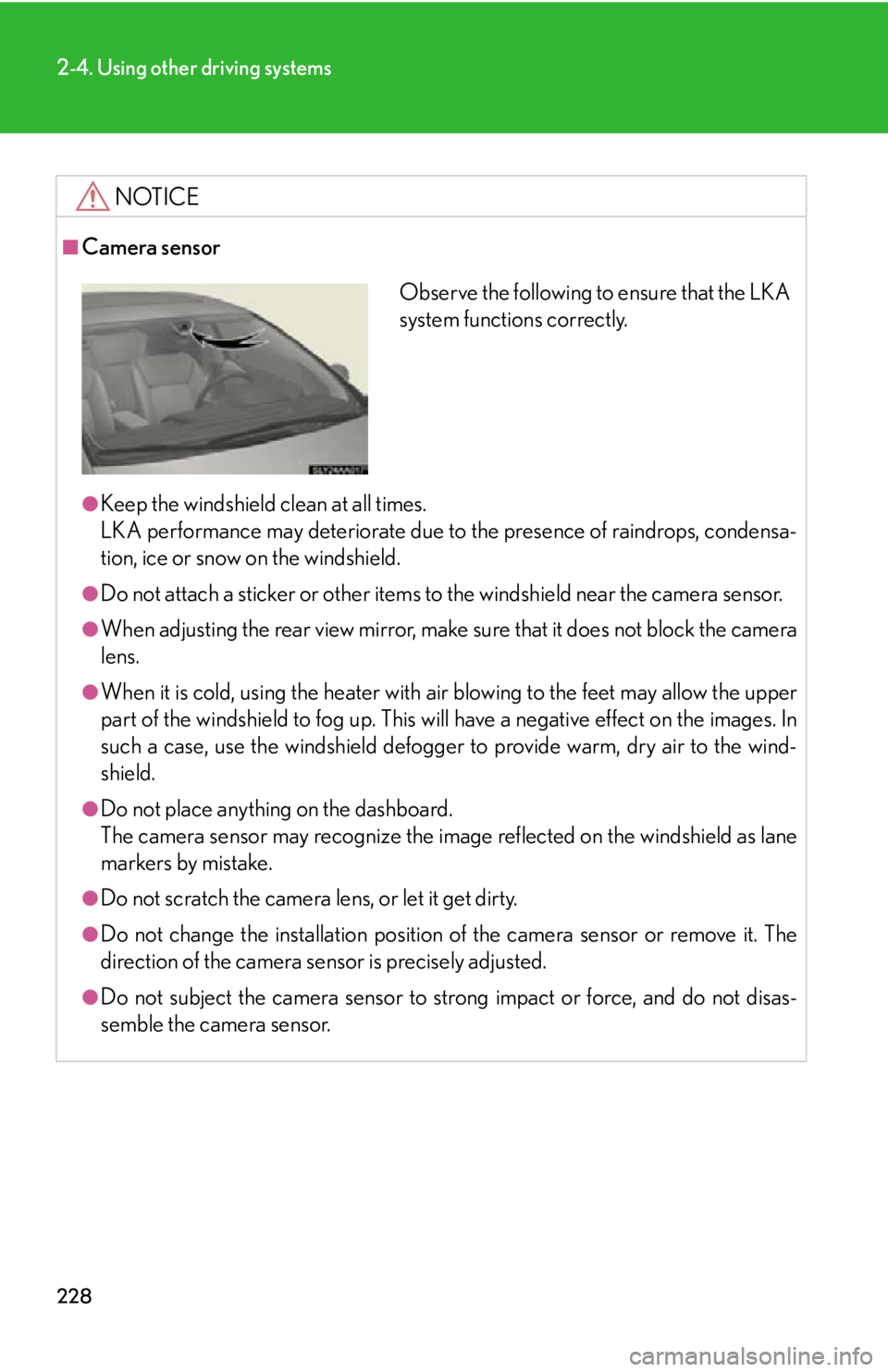
228
2-4. Using other driving systems
NOTICE
■Camera sensor
●Keep the windshield clean at all times.
LKA performance may deteriorate due to the presence of raindrops, condensa-
tion, ice or snow on the windshield.
●Do not attach a sticker or other items to the windshield near the camera sensor.
●When adjusting the rear view mirror, make sure that it does not block the camera
lens.
●When it is cold, using the heater with air blowing to the feet may allow the upper
part of the windshield to fog up. This will have a negative effect on the images. In
such a case, use the windshield defogger to provide warm, dry air to the wind-
shield.
●Do not place anything on the dashboard.
The camera sensor may recognize the image reflected on the windshield as lane
markers by mistake.
●Do not scratch the camera lens, or let it get dirty.
●Do not change the installation position of the camera sensor or remove it. The
direction of the camera sensor is precisely adjusted.
●Do not subject the camera sensor to stro ng impact or force, and do not disas-
semble the camera sensor.
Observe the following to ensure that the LKA
system functions correctly.
Page 229 of 628
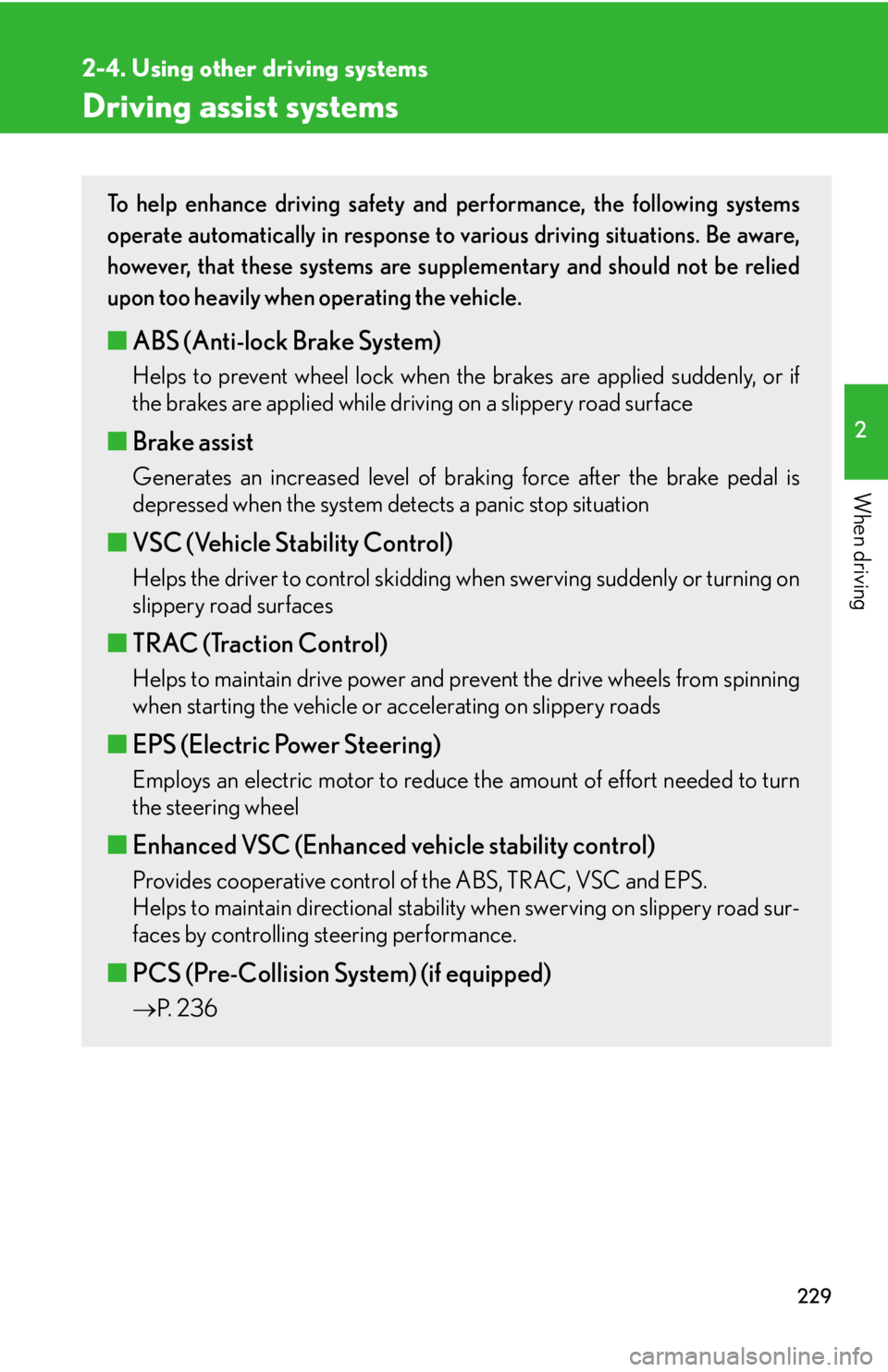
229
2-4. Using other driving systems
2
When driving
Driving assist systems
To help enhance driving safety and performance, the following systems
operate automatically in response to various driving situations. Be aware,
however, that these systems are supplementary and should not be relied
upon too heavily when operating the vehicle.
■ABS (Anti-lock Brake System)
Helps to prevent wheel lock when the brakes are applied suddenly, or if
the brakes are applied while driving on a slippery road surface
■Brake assist
Generates an increased level of braking force after the brake pedal is
depressed when the system detects a panic stop situation
■VSC (Vehicle Stability Control)
Helps the driver to control skidding when swerving suddenly or turning on
slippery road surfaces
■ TRAC (Traction Control)
Helps to maintain drive power and prevent the drive wheels from spinning
when starting the vehicle or accelerating on slippery roads
■EPS (Electric Power Steering)
Employs an electric motor to reduce the amount of effort needed to turn
the steering wheel
■Enhanced VSC (Enhanced vehicle stability control)
Provides cooperative control of the ABS, TRAC, VSC and EPS.
Helps to maintain directional stability when swerving on slippery road sur-
faces by controlling steering performance.
■PCS (Pre-Collision System) (if equipped)
P. 2 3 6
Page 230 of 628
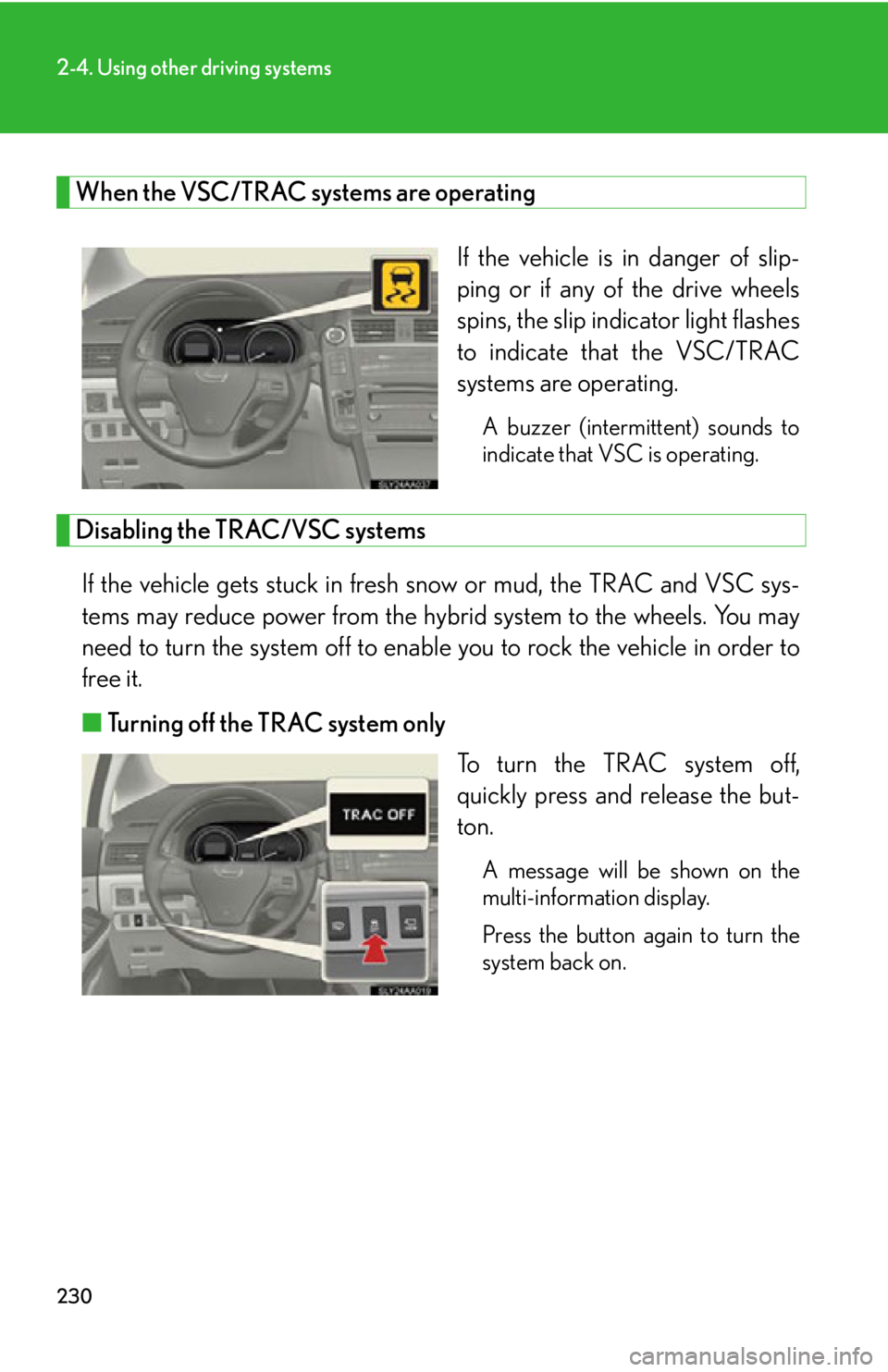
230
2-4. Using other driving systems
When the VSC/TRAC systems are operatingIf the vehicle is in danger of slip-
ping or if any of the drive wheels
spins, the slip indicator light flashes
to indicate that the VSC/TRAC
systems are operating.
A buzzer (intermittent) sounds to
indicate that VSC is operating.
Disabling the TRAC/VSC systemsIf the vehicle gets stuck in fresh snow or mud, the TRAC and VSC sys-
tems may reduce power from the hybr id system to the wheels. You may
need to turn the system off to enable you to rock the vehicle in order to
free it.
■ Turning off the TRAC system only
To turn the TRAC system off,
quickly press and release the but-
ton.
A message will be shown on the
multi-information display.
Press the button again to turn the
system back on.